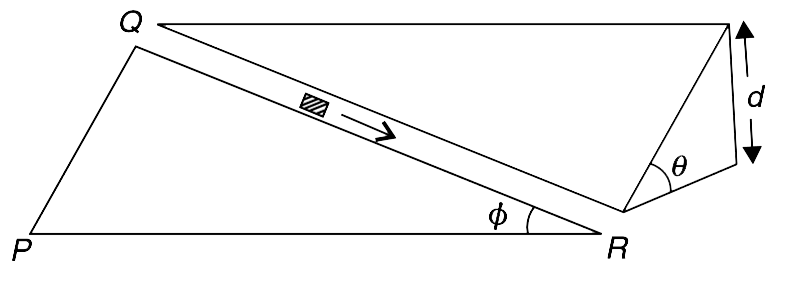There is an inclined surface of inclination θ. A smooth groove is cut into it forming an angle α with AB as shown in figure. A steel ball is free to slide a long the groove. If the ball is released from the point O. Find the speed when it comes to A.

The correct Answer is:[√2glsinθsinα]
Step by step video, text & image solution for There is an inclined surface of inclination theta. A smooth groove is cut into it forming an angle alpha with AB as shown in figure. A steel ball is free to slide a long the groove. If the ball is released from the point O. Find the speed when it comes to A. by Physics experts to help you in doubts & scoring excellent marks in Class 11 exams.
Updated on:21/07/2023Topper's Solved these Questions
- KINEMATICSBook:PHYSICS GALAXY - ASHISH ARORAChapter:KINEMATICSExercise:Advance MCQs with One or More Options Correct
Explore 17 Videos
- GRAVITATIONBook:PHYSICS GALAXY - ASHISH ARORAChapter:GRAVITATIONExercise:Unsolved Numerical
Explore 94 Videos
- LINEAR MOMENTUM & ITS CONSERVATIONBook:PHYSICS GALAXY - ASHISH ARORAChapter:LINEAR MOMENTUM & ITS CONSERVATIONExercise:exercise 1.3
Explore 3 Videos
Similar Questions
Figure shown a fixed surface inclined at an angle θ to the horizontal. A smooth groove is cut on the incline along QR forming an angle ϕ with PR. A small block is released at point Q and it slides down to R in time t. Find t.

View SolutionA table with smooth horizontal surface is fixed in a cabin that rotates with a uniform angular velocity ω in a circular pathof radius R. A smooth groove AB of length L(<<R) is made on the surface of the table. The groove makes an angleθ with the radius OA of the circle in which the cabin rotates. A small particle is kept at the point A in the groove and is released to move along AB. Find the time taken by tehparticle to reach the point B.

View Solution
Knowledge Check
There is inclined surface of inclination θ=30∘. A smooth groove is cut into it forming angle α with AB. A steel ball is free to slide along the groove. If the ball is released from the point O at top end of the groove, the speed when it comes to A is [g=10m/s2]
 A√40m/sB√20m/sC√10m/sD√15m/s
A√40m/sB√20m/sC√10m/sD√15m/sA small object is kept on a groove on rough incline plane of inclination θ. Groove wakes an angle α as shown in diagram. μ coefficient of friction. Which of the following is correct
 ANormal force by incline plane. N=mgcosθBNormal force by incline is N=mg√cos2θ+sin2θsin2αCmaximum frictional force that can develop is fmax=μmgcosθDIf μ=0 then acceleration of blocks is gsinθcosα
ANormal force by incline plane. N=mgcosθBNormal force by incline is N=mg√cos2θ+sin2θsin2αCmaximum frictional force that can develop is fmax=μmgcosθDIf μ=0 then acceleration of blocks is gsinθcosαA ball of mass m is released from A inside a smooth wedge of mass m as shown in figure. What is the speed of the wedge when the ball reaches point B?
 A(a) (gR3√2)1/2B(b) √2gRC(c) (5gR2√3)1/2D(d) √32gR
A(a) (gR3√2)1/2B(b) √2gRC(c) (5gR2√3)1/2D(d) √32gR
A ball starts falling with zero initial velocity on to a smooth inclined plane forming an angle α with the horizontal. Having fallen a distance h, the ball rebounds elastically off the inclined plane. At what distance from the impact point will the ball rebound for the second time ?
View SolutionA ball starts falling with zero initial velocity on to a smooth inclined plane forming an angle α with the horizontal. Having fallen a distance h, the ball rebounds elastically off the inclined plane . At what distance from the impact point will the ball rebound for the second time ?
View SolutionA ball starts falling with zero initial velocity on a smooth inclined plane forming an angle α with the horizontal. Having fallen the distance h, the ball rebounds elastically off the inclined plane. At what distance from the impact point will the ball rebound for the second time?
View SolutionTwo lines AB and CD intersect at O at an inclination α, as shown in figure. If they move out parallel to themselves with the speed v, find the speed of O.

View SolutionA block is placed on an incline having inclination θ . There is a rigid L shaped frame fixed to the block. A plumb line (a ball connected to a thread) is attached to the end A of the frame. The system is released on the inline. Find the angle that the plumb line will make with vertical in its equilibrium position relative to the block when
(a) the incline is smooth
(b) there is friction and the acceleration of the block is half its value when the incline is smooth

View Solution

